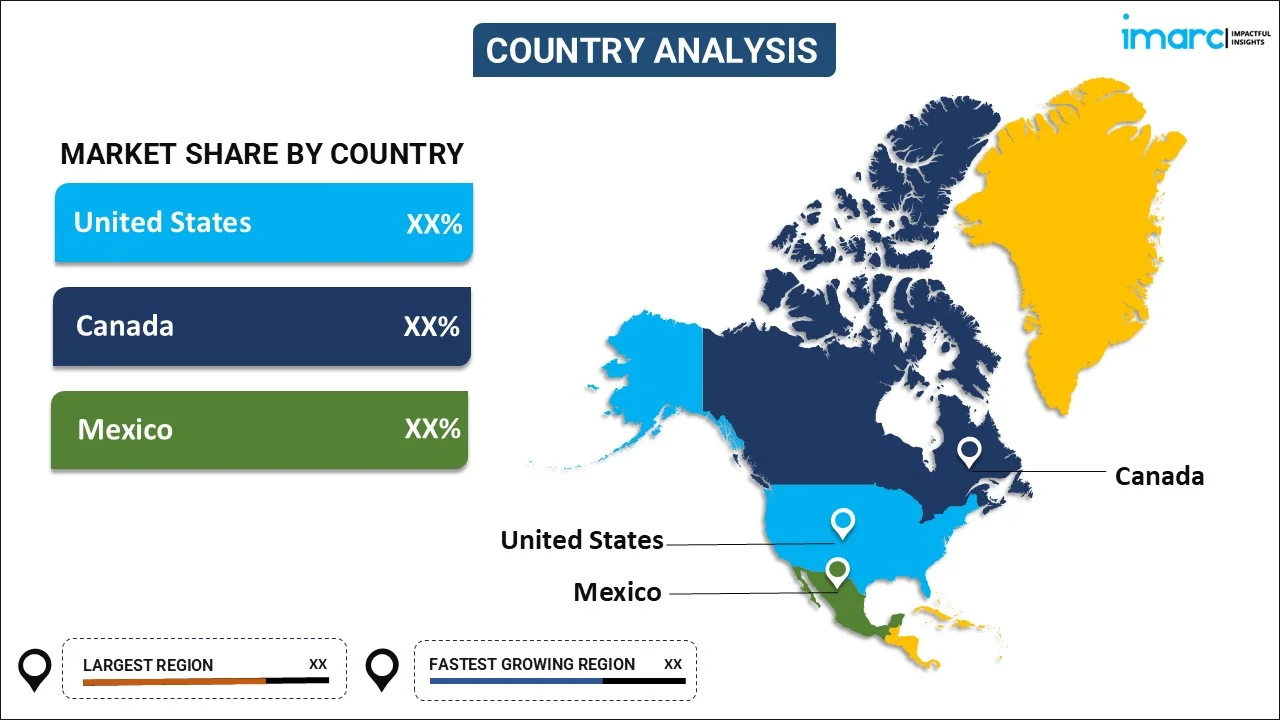
North America Healthcare Cold Chain Logistics Market Report by Product (Biopharmaceuticals, Vaccines, Clinical Trials), Segment (Transportation, Packaging, Instrumentation), and Country 2025-2033
Market Overview:
The North America healthcare cold chain logistics market size reached USD 7.0 Billion in 2024. Looking forward, IMARC Group expects the market to reach USD 10.1 Billion by 2033, exhibiting a growth rate (CAGR) of 3.9% during 2025-2033. The increasing cellular therapies and biomarker testing, escalating need to reduce wastage and financial losses, and surging demand for vaccines to treat numerous diseases among individuals represent some of the key factors driving the market.
|
Report Attribute
|
Key Statistics
|
|---|---|
|
Base Year
|
2024 |
|
Forecast Years
|
2025-2033 |
|
Historical Years
|
2019-2024
|
|
Market Size in 2024
|
USD 7.0 Billion |
|
Market Forecast in 2033
|
USD 10.1 Billion |
|
Market Growth Rate 2025-2033
|
3.9% |
Healthcare cold chain logistics refers to the specialized handling, transportation, and storage of temperature-sensitive pharmaceuticals, vaccines, and biologics to ensure their integrity and efficacy. It involves the use of temperature-controlled environments and equipment throughout the supply chain to maintain the required temperature range and prevent any deviations that could compromise the quality of healthcare products. Cold chain logistics is crucial for preserving the potency and safety of temperature-sensitive healthcare products, as they can be sensitive to temperature variations. It encompasses various activities, including packaging, transportation, monitoring, and quality control, to ensure that these products are maintained within the required temperature conditions from manufacturing to end-use, safeguarding patient health and medication effectiveness.
The increasing demand for temperature-sensitive pharmaceuticals, biologics, and vaccines, coupled with advancements in medical research and biotechnology, has contributed to the uptake of healthcare cold chain logistics in North America. These temperature-sensitive healthcare products require specialized handling and transportation to maintain their efficacy and safety. Moreover, the implementation of stringent regulatory requirements and quality standards imposed by regulatory bodies, such as the U.S. Food and Drug Administration (FDA), have reinforced the importance of maintaining proper temperature controls throughout the supply chain. This, in turn, has accelerated the product adoption rate. Additionally, the increasing complexity and globalization of the pharmaceutical and healthcare supply chains have led to a greater emphasis on end-to-end visibility and traceability. Furthermore, the rise of personalized medicine and biopharmaceuticals has augmented the demand for cold chain logistics, propelling the market growth.
North America Healthcare Cold Chain Logistics Market Trends/Drivers:
Increase in Demand for Biologics and Specialty Pharmaceuticals
The increasing demand for biologics and specialty pharmaceuticals will stimulate the growth of the market in North America. Biologics, including vaccines, gene therapies, and monoclonal antibodies, are complex and delicate products that often require specific temperature conditions to maintain their efficacy. Similarly, specialty pharmaceuticals, such as oncology drugs and immunosuppressants, are often temperature-sensitive and require precise handling throughout the supply chain. The growing adoption of personalized medicine, advancements in biotechnology, and the development of innovative therapies are driving the demand for these specialized pharmaceutical products. As a result, there is an increased need for reliable cold chain logistics services that can ensure the integrity and potency of these temperature-sensitive products.
Rise in Need for Regulatory Compliance
Stringent regulatory compliance is another key driver for the market. Regulatory bodies, such as the U.S. Food and Drug Administration (FDA) and Health Canada, have established stringent guidelines and regulations to ensure the safety, quality, and efficacy of pharmaceuticals and healthcare products. These regulations mandate proper temperature control and traceability throughout the supply chain to prevent the degradation or compromise of temperature-sensitive products. Adhering to these regulatory requirements is crucial for pharmaceutical manufacturers, distributors, and healthcare providers to maintain compliance and ensure patient safety. To meet these regulations, organizations often rely on specialized cold chain logistics providers that have the expertise, infrastructure, and capabilities to maintain strict temperature controls, implement temperature monitoring systems, and provide real-time visibility and traceability.
North America Healthcare Cold Chain Logistics Industry Segmentation:
IMARC Group provides an analysis of the key trends in each segment of the North America healthcare cold chain logistics market report, along with forecasts at the regional and country levels from 2025-2033. Our report has categorized the market based on product and segment.
Breakup by Product:

- Biopharmaceuticals
- Vaccines
- Clinical Trials
Vaccines represents the most popular product
The report has provided a detailed breakup and analysis of the market based on the product. This includes biopharmaceuticals, vaccines, and clinical trials. According to the report, vaccines represented the largest segment.
Vaccines serve as the dominating product in the market due to several key factors. Moreover, the rising importance of vaccines in preventing and controlling infectious diseases has augmented the product demand. Additionally, vaccines play a vital role in public health by safeguarding individuals and communities from various diseases. In line with this, the rising need for timely and reliable distribution of vaccines necessitates a robust cold chain logistics infrastructure to maintain the required temperature conditions and ensure vaccine efficacy is propelling the segment growth. Furthermore, regulatory requirements and stringent quality standards set by regulatory bodies like the U.S. Food and Drug Administration (FDA) demand strict adherence to cold chain protocols. Compliance with these regulations ensures that vaccines maintain their potency and safety throughout the distribution process.
Breakup by Segment:
- Transportation
- Packaging
- Instrumentation
Transportation accounts for the majority of the market share
A detailed breakup and analysis of the market based on the segment has also been provided in the report. This includes transportation, packaging, and instrumentation. According to the report, transportation accounted for the largest market share.
Transportation serves as the dominating segment in the market due to the geographical vastness of the North America region necessitates extensive transportation networks that ensure timely and efficient delivery of temperature-sensitive healthcare products is propelling the segment growth. Besides this, the transportation segment plays a critical role in connecting various nodes of the cold chain, including manufacturing facilities, cold storage centers, healthcare facilities, and distribution points. Furthermore, the increasing demand for healthcare products, particularly temperature-sensitive pharmaceuticals, and biologics, has augmented the need for reliable transportation services. These products require specialized handling and strict temperature control during transit to maintain their efficacy and safety. The transportation segment must ensure seamless and continuous cold chain operations to preserve the integrity of these products throughout the supply chain.
Breakup by Country:

- United States
- Canada
- Mexico
United States hold the largest share in the market
The report has also provided a comprehensive analysis of all the major regional markets, which includes United States, Canada, and Mexico. According to the report, United States was the largest market for healthcare cold chain logistics in North America.
Some of the factors driving the market included the growing prevalence of lifestyle diseases among individuals, increasing cross-border trades, and the rising need to reduce wastage of medical products. The size and complexity of the healthcare industry in the U.S. contribute to its dominance. The country has a large population, high healthcare expenditure, and advanced healthcare infrastructure, which has augmented demand for temperature-sensitive pharmaceuticals, vaccines, and biologics. This demand drives the need for robust cold chain logistics services to ensure the safe and efficient delivery of these products.
Moreover, the presence of major pharmaceutical manufacturers and biotech companies in the United States is positively influencing the market growth. The country is also home to numerous leading healthcare and pharmaceutical companies that require reliable cold chain logistics for their products. These companies often have extensive distribution networks, making the U.S. a crucial hub for cold chain logistics operations. Furthermore, regulatory compliance and quality standards set by organizations like the U.S. Food and Drug Administration (FDA) is contributing to the market growth.
Competitive Landscape:
The key players in the market have made several innovations and advancements to meet the evolving demands of consumers and businesses. Market players have introduced advanced temperature monitoring systems that utilize sensors, data loggers, and real-time monitoring technology to track and monitor temperature conditions during transportation and storage. In addition, key players are developing specialized thermal packaging, insulated containers, and phase-change materials to maintain consistent temperature control and protect products from external temperature fluctuations. These packaging solutions help ensure the stability and quality of healthcare products throughout the cold chain. Additionally, the rising number of strategic collaborations and partnerships between logistics providers, pharmaceutical manufacturers, and regulatory bodies to streamline cold chain processes and ensure compliance with regulatory requirements is supporting the market growth.
The report has provided a comprehensive analysis of the competitive landscape in the market. Detailed profiles of all major companies have also been provided.
North America Healthcare Cold Chain Logistics Market Report Scope:
| Report Features | Details |
|---|---|
| Base Year of the Analysis | 2024 |
| Historical Period | 2019-2024 |
| Forecast Period | 2025-2033 |
| Units | Billion USD |
| Scope of the Report | Exploration of Historical and Forecast Trends, Industry Catalysts and Challenges, Segment-Wise Historical and Predictive Market Assessment:
|
| Products Covered | Biopharmaceuticals, Vaccines, Clinical Trials |
| Segments Covered | Transportation, Packaging, Instrumentation |
| Countries Covered | United States, Canada, Mexico |
| Customization Scope | 10% Free Customization |
| Post-Sale Analyst Support | 10-12 Weeks |
| Delivery Format | PDF and Excel through Email (We can also provide the editable version of the report in PPT/Word format on special request) |
Key Benefits for Stakeholders:
- IMARC’s report offers a comprehensive quantitative analysis of various market segments, historical and current market trends, market forecasts, and dynamics of the North America healthcare cold chain logistics market from 2019-2033.
- The research study provides the latest information on the market drivers, challenges, and opportunities in the North America healthcare cold chain logistics market.
- Porter's five forces analysis assist stakeholders in assessing the impact of new entrants, competitive rivalry, supplier power, buyer power, and the threat of substitution. It helps stakeholders to analyze the level of competition within the North America healthcare cold chain logistics industry and its attractiveness.
- Competitive landscape allows stakeholders to understand their competitive environment and provides an insight into the current positions of key players in the market.
Key Questions Answered in This Report
The North America healthcare cold chain logistics market was valued at USD 7.0 Billion in 2024.
We expect the North America healthcare cold chain logistics market to exhibit a CAGR of 3.9% during 2025-2033.
The rising demand for outsourcing operations across the pharmaceutical and biopharmaceutical sectors for drugs, vaccines, clinical trial materials, etc., is primarily driving the North America healthcare cold chain logistics market.
The sudden outbreak of the COVID-19 pandemic has led to the increasing utilization of healthcare cold chain logistics for storing and transporting various temperature-sensitive healthcare products and vaccines across numerous North American nations.
Based on the product, the North America healthcare cold chain logistics market has been segmented into biopharmaceuticals, vaccines, and clinical trials. Among these, vaccines currently hold the majority of the total market share.
Based on the segment, the North America healthcare cold chain logistics market can be divided into transportation, packaging, and instrumentation. Currently, transportation exhibits a clear dominance in the market.
On a regional level, the market has been classified into United States, Canada, and Mexico, where United States currently dominates the North America healthcare cold chain logistics market.
Need more help?
- Speak to our experienced analysts for insights on the current market scenarios.
- Include additional segments and countries to customize the report as per your requirement.
- Gain an unparalleled competitive advantage in your domain by understanding how to utilize the report and positively impacting your operations and revenue.
- For further assistance, please connect with our analysts.
 Request Customization
Request Customization
 Speak to an Analyst
Speak to an Analyst
 Request Brochure
Request Brochure
 Inquire Before Buying
Inquire Before Buying




.webp)




.webp)












